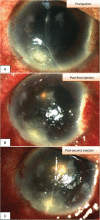Treatment with intrastromal and intracameral voriconazole in 2 eyes with Lasiodiplodia theobromae keratitis: case reports
- PMID: 25674759
- PMCID: PMC4602755
- DOI: 10.1097/MD.0000000000000541
Treatment with intrastromal and intracameral voriconazole in 2 eyes with Lasiodiplodia theobromae keratitis: case reports
Abstract
To report the clinical presentation and the role of intrastromal and intracameral voriconazole injection in the management of rare cases of fungal keratitis caused by Lasiodiplodia theobromae.Two eyes of 2 patients with Lasiodiplodia keratitis unresponsive to topical and oral antifungal medications were included in this study. Diagnosis of Lasiodiplodia keratitis was confirmed by microbiological analysis, including culture-based (case 1 and 2) and DNA sequencing techniques (case 2 only).The first patient presented with multiple satellite lesions and one of these infiltrates spread deeply into the cornea, forming a stromal abscess. Another patient had a large full-thickness corneal infiltrates with several fungal balls in the anterior chamber, requiring a limbus-to-limbus therapeutic penetrating keratoplasty. Despite aggressive topical therapy, the stromal abscess continued to worsen in the first case and recurrent keratitis was observed postoperatively in the second case. Voriconazole 50 μg/0.1 mL was administered intracamerally and intrastromally around the fungal abscess as adjuncts to topical antimycotics in the first case. The second patient who needed therapeutic keratoplasty was treated with an intracameral injection of 50 μg/0.1 mL voriconazole at the end of surgery. Postoperatively, 100 μg/0.1 mL voriconazole was also injected intracamerally after the recurrence of infection was noted in the graft. Reinjections were given 48 hours apart in both cases. After the injections, all corneal and anterior chamber lesions were reduced in size and density and completely resolved within 4 weeks.Intrastromal and intracameral voriconazole injections may offer safe and effective treatment options for L theobromae keratitis.
Conflict of interest statement
The authors have no funding and conflicts of interest to disclose.
Figures


Similar articles
-
Combination of intracameral and intrastromal voriconazole in the treatment of recalcitrant Acremonium fungal keratitis.Middle East Afr J Ophthalmol. 2012 Apr-Jun;19(2):265-8. doi: 10.4103/0974-9233.95271. Middle East Afr J Ophthalmol. 2012. PMID: 22623874 Free PMC article.
-
Treatment of Alternaria keratitis with intrastromal and topical caspofungin in combination with intrastromal, topical, and oral voriconazole.Ann Pharmacother. 2011 May;45(5):e24. doi: 10.1345/aph.1P586. Epub 2011 Apr 26. Ann Pharmacother. 2011. PMID: 21521864
-
Intracameral voriconazole for severe fungal keratitis: a case series.Arq Bras Oftalmol. 2025 Jan 27;88(3):S0004-27492025000300312. doi: 10.5935/0004-2749.2024-0207. eCollection 2025. Arq Bras Oftalmol. 2025. PMID: 39879413
-
Lasiodiplodia theobromae keratitis: a case report and review of literature.Mycopathologia. 2012 Oct;174(4):335-9. doi: 10.1007/s11046-012-9546-7. Epub 2012 Apr 28. Mycopathologia. 2012. PMID: 22544631 Review.
-
Favorable outcome of Lasiodiplodia theobromae keratomycosis : a clinical case and systematic review.BMC Ophthalmol. 2024 Aug 8;24(1):332. doi: 10.1186/s12886-024-03599-z. BMC Ophthalmol. 2024. PMID: 39118115 Free PMC article.
Cited by
-
Effect of γ-Aminobutyric Acid (GABA) on the Metabolome of Two Strains of Lasiodiplodia theobromae Isolated from Grapevine.Molecules. 2020 Aug 23;25(17):3833. doi: 10.3390/molecules25173833. Molecules. 2020. PMID: 32842542 Free PMC article.
-
Voriconazole-impregnated multilayered AMT and intracorneal plus intracameral injection in recalcitrant fungal corneal ulcer.BMJ Case Rep. 2022 Mar 29;15(3):e246659. doi: 10.1136/bcr-2021-246659. BMJ Case Rep. 2022. PMID: 35351742 Free PMC article.
-
Secondary Metabolites of Lasiodiplodia theobromae: Distribution, Chemical Diversity, Bioactivity, and Implications of Their Occurrence.Toxins (Basel). 2020 Jul 17;12(7):457. doi: 10.3390/toxins12070457. Toxins (Basel). 2020. PMID: 32709023 Free PMC article. Review.
-
Recent advances in diagnosis and management of Mycotic Keratitis.Indian J Ophthalmol. 2016 May;64(5):346-57. doi: 10.4103/0301-4738.185592. Indian J Ophthalmol. 2016. PMID: 27380973 Free PMC article. Review.
-
Antifungal Susceptibility, Morphological and Molecular Characterization of Lasiodiplodia theobromae Isolated from a Patient with Keratitis.Mycopathologia. 2018 Jun;183(3):565-571. doi: 10.1007/s11046-017-0234-5. Epub 2018 Jan 30. Mycopathologia. 2018. PMID: 29383575
References
-
- Puttanna ST. Mycotic infections of the cornea. J All India Ophthalmol Soc 1967; 15:11–18. - PubMed
-
- Laverde S, Moncada LH, Restrepo A, et al. Mycotic keratitis; 5 cases caused by unusual fungi. Sabouraudia 1973; 11:119–123. - PubMed
-
- Valenton MJ, Rinaldi MG, Butler EE. A corneal abscess due to the fungus Botryodiplodia theobromae. Can J Ophthalmol 1975; 10:416–418. - PubMed
-
- Rebell G, Forster RK. Lasiodiplodia theobromae as a cause of keratomycoses. Sabouraudia 1976; 14:155–170. - PubMed
Publication types
MeSH terms
Substances
LinkOut - more resources
Full Text Sources
Medical

